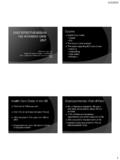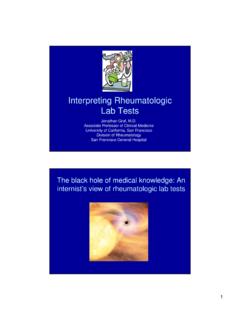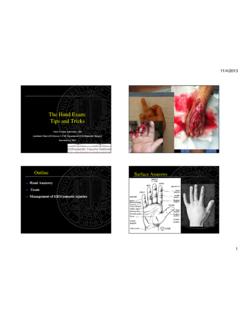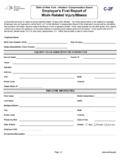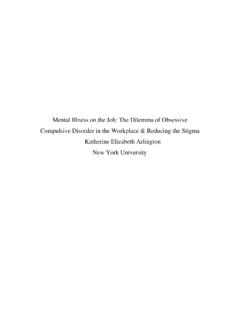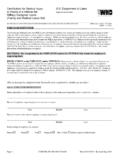Transcription of Nutrition Therapy in Critical Illness - UCSF CME
1 Nutrition Therapy in Critical IllnessJami Baltz, RD, CNSDSan Francisco General Hospital and Trauma Discuss the hypermetabolism of the systemic inflammatory response and how it relates to Nutrition and metabolic response. Identify the uses of enteral Nutrition to address nutritional and inflammatory issues. Demonstrate the inadequacies of traditional approaches to Nutrition assessment, intervention, and SupportSupportSupportTherapy: Modulating the Stress Response and Systematic ImmunityAdjunctive Supportive CareProactive Primary TherapyRationale for Nutrition in the ICU Current Goals: " Therapy not support"Evidence-based risk reduction attenuate metabolic response limit and reverse loss of lean body tissue prevent oxidant stress favorably modulate immune responseMartindale R, Maerz L.
2 Current Opin Crit Care 12:290-294,2006 Metabolic Comparisons: Stress vs. Starvation Urine Nitrogen Loss Proteolysis Protein Synthesis Plasma Lipids Ketogenesis Blood Glucose Gluconeogenesis Insulin GlucagonMixedFatPrimary Fuels RQ REES tressStarvationMetabolic Changes to Stress:Resting Energy Expenditure3 phases of metabolic response Ebb Phase = Stress (0-48 hours) Cardiac Output Tissue perfusion Oxygen Consumption REEN utritional Goal: Metabolic Support3 Phases of metabolic response Flow Phase = catabolic (24+hours) cytokines Counterregulatory hormones and catecholamines Insulin O2 consumption, REE Catabolism Hyperglycemia, + fluid balance, - N balance Shift toward production of positive acute phase reactantsNutritional Goal.
3 Metabolic Support3 Phases of Metabolic Response Repletion Phase = anabolic Can last for months May need up to 130% REE to support tissue repair, repletion, and recoveryNutritional Goal: shift from metabolic support to promotion of repletionComparison of Measured Metabolic Rate2015 (RQ )101492 (RQ )31820 (RQ )17 Measured Metabolic RateHospital DayHow can Nutrition affect Metabolic Response? Enteral preferred to Parenteral Early Initiation of Enteral Nutrition Appropriate macro and micronutrients Avoid Under/overfeeding Pharmoconutients Meticulous glycemic controlEnteral is Superior to ParenteralHuman Studies: Enteral vs TPNWhat Does the Data Show?AuthorMooreKudskHasseReynoldsShirab eKalfarentzosWindsorGramlichPopulationTr aumaTraumaHepatic transplantGI surgeryHepatic resectionPancreatitisPancreatitisMeta-an alysisYear8992959697979804 Benefit Infections Infections Infections Infections Infections Sepsis/Comp MOF/SIRS infections48 studies in adult populations(46 in english literature)20 surgical, 9 Critical care, 7 pancreatitis, 5 IBD, 3 Hepatic disease,3 mixed populationsGeneral conclusions: fewer infections, shorter hospital stayTPN risks:Systemic Immune Suppression Mucosal atrophy/GALT atrophy Overfeeding and hyperglycemia IV Lipids Catheter InfectionsUse of TPN in Critical Care EN always first choice for Nutrition Therapy Second choice depends on: Timing.
4 First week - STD (NPO) After first week - PN Malnutrition (weight loss) - Prioritiesreversed No other options for IV fat source (Intralipid) Omit if PN used over first week Minimal use of supplemental PN (no use first week)Heyland (JAMA 1998; 280:2013), Braunschweig (AJCN; 74:534), McClave (JPEN 2009; 33:277)IV Lipids and Immune Function:Clinical Trials Immune functionomega 3 inflammationIV LCTO mega 3 vs Omega 6 EsophagSepsis23219903 FurukawaMayer WBC functionVariousHome TPNx97 Waitzberg infection+/- IV LCTT rauma5597 Battisella2x infectionHigh/LowBurn4395 GarrelOutcomeDesignPopulationNYRA uthorDietary -6 FADietary -6 FAMembrane phospholipidslipoxygenasecyclooxygenasel ipoxygenaseDietary -3 FADietary -3 FAArachidonic acidEicosapentaenoic acid (EPA)Docosahexaenoic acid (DHA)Leukotrienes(4 series)Proinflammatory Cell adhesiveChemotacticProstanoids & Thromboxanes(2 series)Aggregates plateletsImmunosuppressiveProstanoids & Thromboxanes(3 series)AntiaggregatoryNon-immunosuppress iveLeukotrienes(5 series)
5 Anti-inflammatoryNonadhesiveYou Are What You EatYou Are What You EatThe Anti-Inflammatory Effects of Enteral Nutrition Enteral Nutrition can directly affect inflamed intestine Enteral Nutrition can blunt acute inflammatory reactants Enteral formulas can have direct effect on cytokine/adhesion molecule expression by intestinal epitheliumSanderson JPEN, 2005; 25:S134 Early is Better than LaterEarly Enteral Feeding Meta-analysisTrend to infections and mortality8 studies<24 to 48 hrHeyland. JPEN. 2003. Infections LOS Vomiting risk11 studies837 patientsNPO vs <24 hrLewis. BMJ. 2001. Infections LOS15 studies753 patientsFeeding < or >36 hrMarik. CCM. DesignStudy ParametersAuthor/Journal Effects of Early Enteral Feeding on the Outcomeof Critically Ill Ventilated Medical Patients ICU patients Retrospective review of prospectively collected data N=4049 2537 patients fed < 48 hours 1512 patients fed > 48 hours Propensity scoring system to control for confounding variables Conclusions: 20% decrease in ICU mortality ( vs ) 25% decrease in hospital mortality ( vs ) Influence greatest in sickest patients Beneficial effect noted despite increase in VAP ICU patients Retrospective review of prospectively collected data N=4049 2537 patients fed < 48 hours 1512 patients fed > 48 hours Propensity scoring system to control for confounding variables Conclusions.
6 20% decrease in ICU mortality ( vs ) 25% decrease in hospital mortality ( vs ) Influence greatest in sickest patients Beneficial effect noted despite increase in VAPA rtinian V et al Chest 2006;129:960-967 Effect of Early EN Local Innate Immunity Commensal Organisms Systemic Acquired Immunity Gut-Lung Conduit for InflammationKudsk (Amer J Surg 2002; 183:390)Gut Associated Lymphoid BM, spleen, x 1010Ig producing cells x 1010Ig producing cellsQuantityQuantity Cumulative energy deficit correlated to:1 Longer ICU stay More days on mechanical ventilation More complications Underfeeding2 Lowest quartile (<6kcals/kg/day) Increase risk bloodstream infections Overfeeding3 Highest tertile (>66% recommended) Highest mortality Least likely to breath spontaneously at d/c Middle tertile had best outcomes1 Villet (Clin Nut 2005) 2 Robinson (Crit Care Med 2004) 3 Krishnan (Chest 2003)
7 Consequences of Underfeeding Respiratory dysfunction Respiratory muscle strength Ventilatory response Failure to wean Low transport proteins in the absence of inflammation Poor wound healingConsequences of Overfeeding Hyperglycemia Electrolyte imbalances Fluid overload Hyperlipidemia Organ dysfunction Hypermetabolism Failure to wean (CO2retention)Nutrient Delivery in Surgery and Critically Ill Populations Calories 20-35 kcal/kg/day Carbohydrates 3-6 mg/kg/min 250-350 gm/day Protein - gm/kg/day 80-150 gm/day Lipids 10-30% of total calories Dependent on lipid composition Vitamins/minerals/trace elements Adequate to meet needsPharmoconutrients Glutamine Omega 3 fish oils Arginine Anti-Oxidants Glutamine: role in gut protection in Critical Illness Critical Illness Alteration of gut epithelial cell function +/- data for bacterial translocation Gut as a source of pro-inflammatory cytokines Therapy should be targeted at Protect epithelial from cell injury Attenuate the elaboration of proinflammatory mediators via gut based immune cellsWischmeyer , PE Curr Opin Clin Nutr Metab Care 9.
8 607-612,2006 Proposed mechanisms for glutamines ability to attenuate the SIRS response Tissue protection Heat shock protein Anti-apoptotic effect Fuel source for epithelial cells Anti-inflammatory Attenuate NFkB Enhanced PPAR activation Attenuation of cytokine expression Preservation of tissue function in stress states Preserves ATP in sepsis and I/R Preserves mitochondrial function Antioxidant Enhanced GSH Attenuates iNOS in sepsis and I/R Reduction in oxidant stressWischmeyer , PE Curr Opin Clin Nutr Metab Care 9:607-612,2006 Enteral Feeding with EPA+GLAC linical Outcomes SummaryX 1X 6 Reduced mortality 7 4 1 6 2,3,5 SafetyX 4 Pediatric BurnX 1X 2,3 Fewer new organ failures Pediatric ICUX 1X 1X 1 Sepsis X 6X 6X 6 ALIX 3X 2,3X 2,3,5 ARDSLess time on ventReduced ICU LOSI mproved oxygenstatusStudy Population1.
9 Pontes-Arruda A, et al: Crit Care Med 2006;34(9) Elamin E, et al: CHEST2005;128 Gadek J, et al: Crit Care Med1999;27 , T, et al: J Burn Care Res2008;29 Pacht E,et al:Crit Care Med 2003:31(2) Singer P, et al: Crit Care Med2006;34 Nadkarni V, et al: Crit Care Med2005;33(Supp12) = statistically significant = EPA+GLA diet was found to be safe in these patient populations. Safety variables measured were no different from the control ALI/ARDS Inflammatory ResponseTypical ALI/ARDS Inflammatory ResponsePrecipitatingeventIncrease inneutrophilrecruitmentProinflammatoryei cosanoids andfree radicalsproducedPulmonaryinflammationwit h loss of surfactant, edema andvasoconstrictionImpaired gasexchange andpoor oxygenationLeading to deterioration of patient s conditionImmune Cell on Normal LipidsPhospholipidMembraneAAAAAAAAAAAAAA AAAA Arachinodic Acid -Proinflammatory compoundsImmune Cell on Special Fatty AcidsGOAL.
10 DGLAAAAAAA Less in cellmembraneDGLADGLAEPAEPAEPAA rginine Necessary for normal T lymphocyte function Myeloid suppressor cells regulate availability of arginine Myeloid suppressor cells are capable of causing states of severe arginine deficiency which impact production of nitric oxide Process is paralyzed during trauma and surgery -appears to be an arginine deficiency But NOT during sepsis!!! (when arginine metabolized, NO is produced)(Popovic J. Nutr. 2007; 137:1681S)QuickTime and aTIFF (LZW) decompressorare needed to see this and aTIFF (LZW) decompressorare needed to see this and aTIFF (LZW) decompressorare needed to see this Nutrition Therapy in Critical Care Indirect Calorimetry Albumin PreAlbumin Nitrogen BalanceIndications for Conducting RMR Measurements Inability to estimate energy expenditure with accuracy Inadequate clinical response using predictive equations Possible signs of malnutrition Possible signs of overfeedingIndirect Calorimetry Measure change in concentration of inspired oxygen (vO2in ml/min) and carbon dioxide excretion (vCO2in ml/min) to determine resting metabolic rate (RMR) RMR (kcal/d) = {VO2( ) + VCO2( )}

